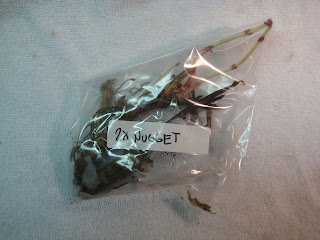We have begun the adventure of all-grain brewing (update to follow), but before we could start we needed even more new equipment. The most important being a large vessel to boil in. Stainless steel kettles are a bit pricey. The alternative is a modified keg. So we decided to make our own. Aaron legally procured a 15.5 gallon stainless steel keg which was in excellent shape. For this project we refered to Brew Ware - Lutzen & Stevens to guide us through the process.
We decided to base the diameter of the opening that we cut into the top of the vessel on the diameter of a spare lid from a 3 gallon kettle (which was 9") that we had sitting around. The paln was to purge the keg of any pressure and use a drill to make a hole on the line laid out for the opening. Then we would use a reciprocating saw to cut the opening by inserting the blade into the hole that we had drilled.
This proved to be much harder then anticipated for several reasons. First stainless steel is strong, seriously strong (I know that sounds like a no shit kind of statement but it was extremely difficult to work with and neither Aaron nor myself really anticipated just how difficult it was.). Even the 8.0 amp drill we used had a bit of difficulty getting a start into the material. The second reason was that the reciprocating saw that we had was good and power full but ran way too fast and had no speed adjustment capability. It wanted to jump around all over the place before it would beging to make a cut. Which intimidated me a bit too much for comfort. Safety was a major concern here for both of us. We took all the precautions that we found to common sense and that we recommended by the authors of the referance book (Safety glasses! Take it slow!). Neither of us wanted to risk injury (or for that matter ruining the keg), so when we reached this point we decided it was time to take a different approach.
I called my Grandfather, Joe Trinkwalder a man who has profoundly more experiance with such things than either Aaron or I. He suggested that we use a small saw with specialty blades that he had and some cutting oil to keep the blades cool while cutting (Brew Ware suggests that you may go through up to five blades). So we got started. I kept a constant flow of cutting oil on the blade while my Grandfather made the cut.
A messy, smokey process.
Making the cut.
Cleaning up the oil.
Drilling the holes for the thermometer and ball valve.
The process for cutting the main hole took about twenty minutes. Drilling the holes for the brewing thermometer and the ball valve took just a few minutes more. Two blades and a quart of cutting oil were the only casualties. Everything went smooth and safely. I later used a small angle grinder to clean up any burrs left on the holes. I also used it to widen the main opening just slightly so that the lid fit nice and snug.
Installing the ball valve.
A cold OV to celebrate!
The kettle screen installed.
The finished product.
In Primary:
- Blonde Ale (update to follow)
Lagering:
- Genther Bock















